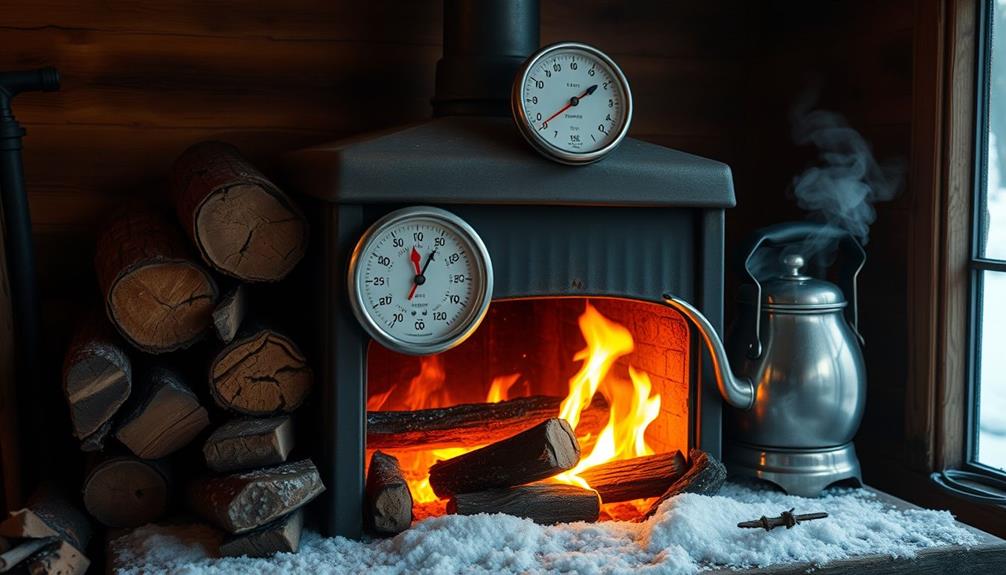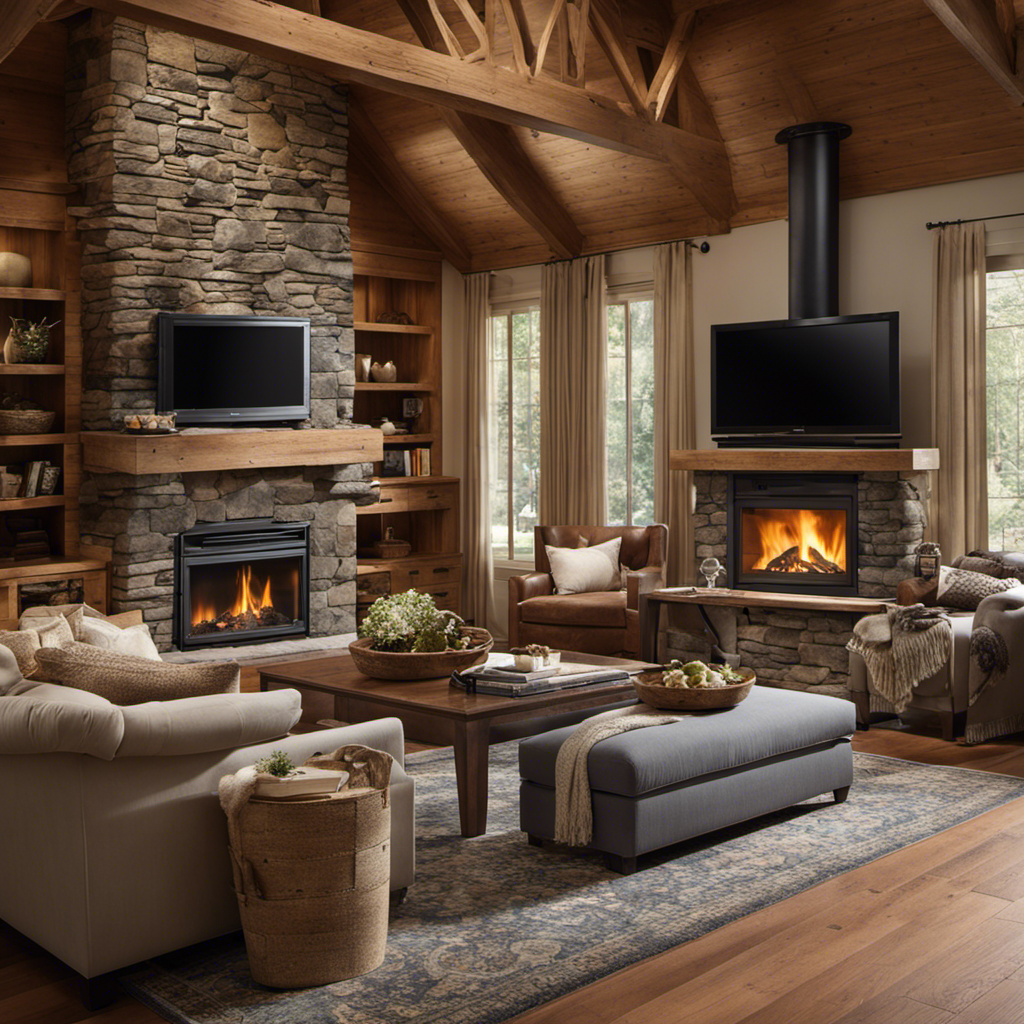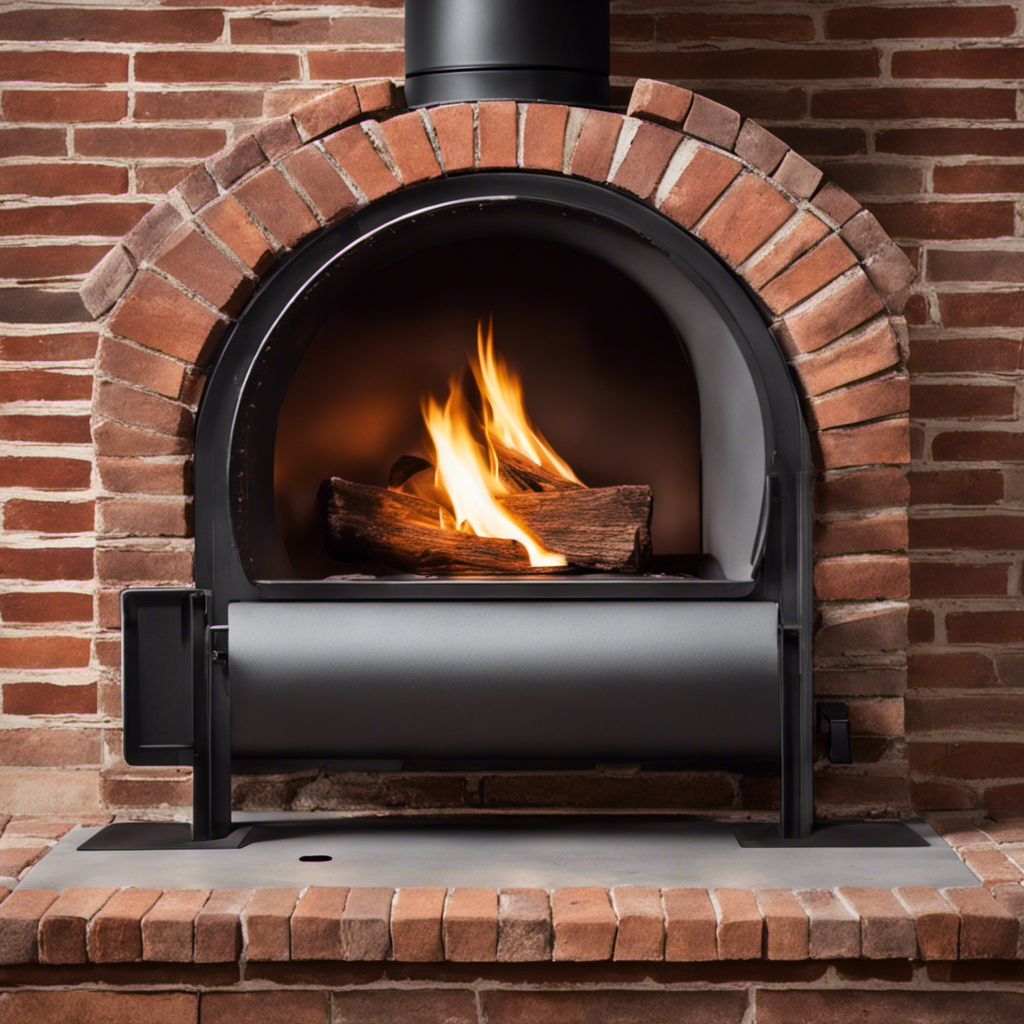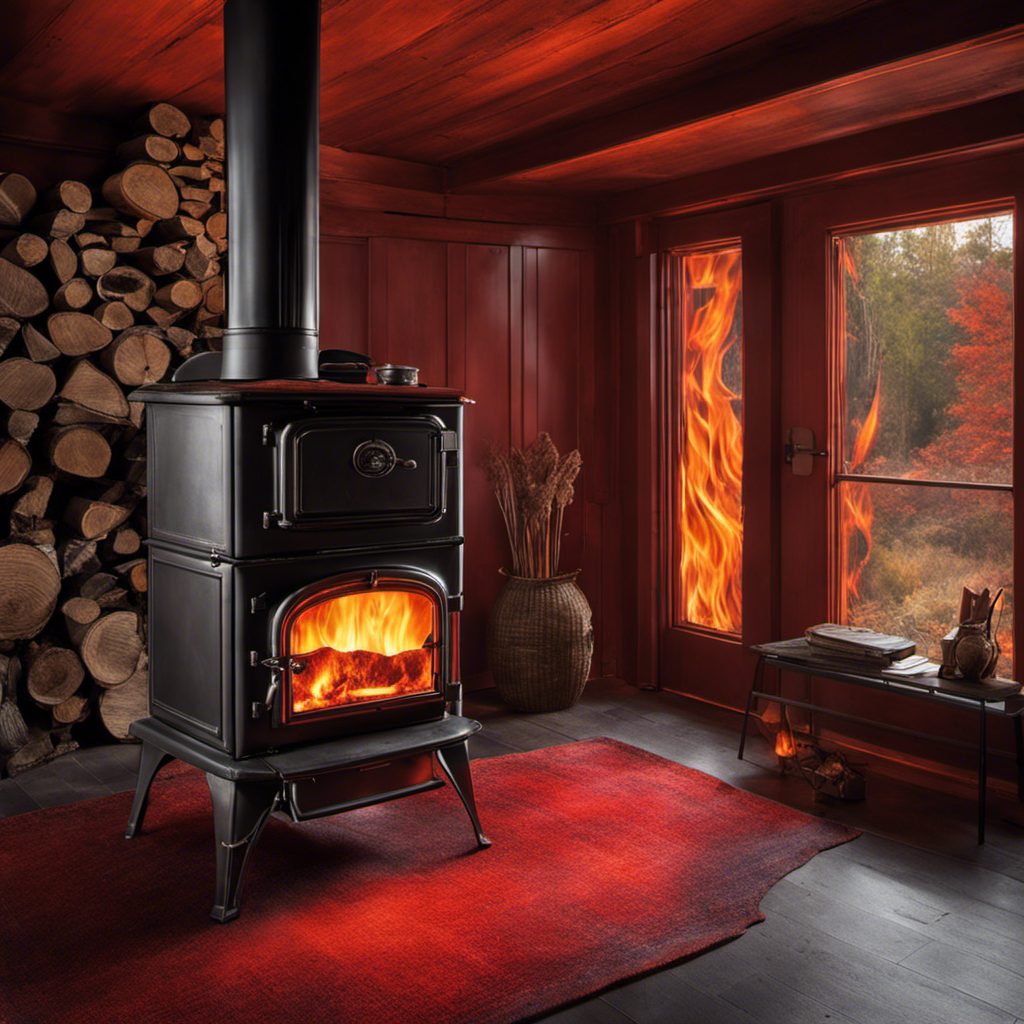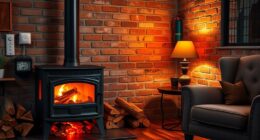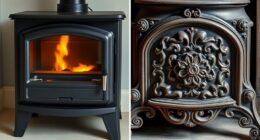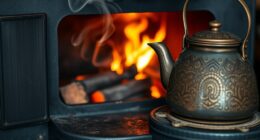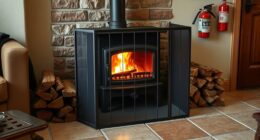Wood stove thermometers are essential for maintaining safety and efficiency in your heating system. They help monitor stove and flue temperatures, preventing issues like creosote buildup and overheating. By keeping an eye on the ideal stovepipe temperatures, you can enhance fuel efficiency and reduce emissions. To use them effectively, place thermometers correctly—stove top models near the back and flue models 10-18 inches above the stove. Regular maintenance is key to ensuring accuracy. With the right knowledge and practices, you'll optimize your wood stove experience and safety—there's plenty more to uncover about maximizing your stove's performance.
Key Takeaways
- Wood stove thermometers ensure safety by monitoring temperatures, preventing creosote buildup, and reducing risks of overheating fires.
- Accurate temperature readings improve fuel efficiency, minimizing consumption and lowering heating costs while reducing emissions.
- Proper thermometer placement is crucial; stove top thermometers should be near the back, while flue pipe thermometers should be 10-18 inches above the stove.
- Regular maintenance, including cleaning and calibration checks, is essential for reliable thermometer performance and accuracy.
- Engaging with wood stove user communities enhances knowledge sharing on best practices for thermometer usage and troubleshooting.
Importance of Wood Stove Thermometers
Wood stove thermometers play an important role in ensuring your stove operates safely and efficiently. By monitoring both stove and flue temperatures, these thermometers help you prevent creosote buildup, a leading cause of chimney fires. They keep your burning temperatures ideal, greatly reducing fire hazards.
Proper combustion management, much like the thermal energy transfer basics, is essential for maximizing the efficiency of your heating system.
When you read accurate temperature readings from your wood stove thermometer, you can enhance fuel efficiency, which leads to lower fuel consumption and reduced emissions. This means you not only save money but also contribute to a cleaner environment.
Additionally, wood stove thermometers assist you in regulating burn rates, preventing overheating that can damage metal components and shorten your stove's service life. With a reliable thermometer, you can adjust your air intake and manage combustion better, improving overall heating efficiency.
Regular monitoring with these thermometers allows you to identify potential operational issues early, promoting safer and more efficient wood stove usage.
Whether you're a seasoned user or just starting out, investing in a wood stove thermometer is essential for maintaining a safe and effective heating solution in your home.
Types of Thermometers Available

When choosing a wood stove thermometer, you'll find several types that each measure temperature differently. Understanding the accuracy and proper placement of these thermometers is essential for effective stove operation.
Additionally, it's important to take into account how reputation and reviews from past clients can guide your selection of a reliable thermometer.
Let's explore the various options available and how to get the most out of them.
Measurement Methods Overview
A variety of thermometers are available to help you accurately measure temperatures in your wood stove setup. Understanding these options can enhance your stove's efficiency and safety. Here's an overview of the main types you might consider:
| Thermometer Type | Measurement Method | Key Features |
|---|---|---|
| Stove Top Thermometer | Measures temperature directly on the stove | Immediate feedback on efficiency |
| Flue Pipe Thermometer | Installed on flue pipes to monitor exhaust | Safety and performance insight |
| Infrared Thermometer | Non-contact readings from a distance | Quick monitoring but less reliable |
When selecting a thermometer, consider how each option fits your needs. For instance, a flue pipe thermometer is essential for monitoring the operating temperature of exhaust gases, ensuring your stove runs safely. On the other hand, digital thermometers can provide instant readings and come with added features like alarms. Remember, precise temperature measurement can lead to a more efficient and safer wood stove experience.
Accuracy and Placement Tips
Achieving accurate temperature readings in your wood stove setup is important for both efficiency and safety. Properly monitoring your wood stove's temperature can also prevent overheating, which is essential for maintaining the longevity of your stove.
There are several types of thermometers you can use: stove top thermometers provide direct surface readings, stovepipe thermometers monitor flue temperatures, and probe thermometers measure internal flue gas temperatures.
For maximum accuracy, place stove top thermometers near the back of the stove. Stovepipe thermometers should be installed 10-18 inches above the stove to guarantee reliable flue temperature monitoring.
While magnetic thermometers are convenient, they can lose accuracy over time, especially on double-wall pipes. Regular checks are critical to maintain their reliability.
When considering accuracy, digital thermometers are a great choice, offering quick readings in just three seconds. However, probe thermometers require careful installation to avoid leaks and guarantee precise flue gas temperature measurements.
Regular cleaning and calibration checks are also necessary to maintain the accuracy of all thermometers, particularly those exposed to high heat. By following these placement tips and keeping your thermometers well-maintained, you'll assure that your wood stove operates efficiently and safely.
For additional insights into maintaining such systems, consider exploring pool construction guidelines.
Benefits of Accurate Temperature Monitoring

Accurate temperature monitoring with your wood stove not only boosts fuel efficiency but also enhances safety.
By keeping an eye on the temperatures, you can prevent dangerous creosote buildup and avoid overheating, ultimately protecting your stove.
Additionally, understanding proper flushing practices can help maintain a safe environment in your home.
You'll enjoy a more efficient heating experience while minimizing risks in your home.
Fuel Efficiency Improvement
Monitoring your wood stove's temperature with a thermometer can dramatically enhance fuel efficiency. By keeping an eye on the temperature, you optimize combustion efficiency, which reduces fuel consumption and lowers your heating costs. Aim for a stovepipe temperature around 300°F during long burns to decrease creosote buildup and improve overall performance.
Here's a quick look at how temperature monitoring affects your wood stove:
| Temperature Monitoring Benefits | Impact on Fuel Efficiency |
|---|---|
| Ideal Stovepipe Temp (300°F) | Reduces creosote buildup |
| Adjust Air Intake Settings | Maximizes heat output |
| Monitor Temperature Fluctuations | Prevents unnecessary refuels |
| Identify Fuel Use Patterns | Informs better heating decisions |
| Lower Heating Costs | Overall improved efficiency |
With regular use of thermometers, you can make precise adjustments that lead to efficient burning. You'll know when to refuel, preventing unnecessary fires that waste fuel and contribute to emissions. Ultimately, accurate temperature monitoring not only saves you money but also enhances your wood stove's performance and longevity.
Enhanced Safety Measures
Keeping a close watch on your wood stove's temperature not only boosts fuel efficiency but also greatly enhances safety measures. By regularly monitoring your stove's temperature, you can prevent excessive smoke production, which leads to dangerous creosote buildup in your chimney. This buildup notably increases fire hazards, so it's important to take it seriously.
Additionally, using a thermometer can help you maintain the ideal burn rates for your wood, similar to how a self-cleaning brush roll maintains vacuum performance by keeping hair from wrapping around the brush.
Using a thermometer allows you to maintain ideal temperature ranges, helping you avoid overheating that can damage your stove's metal components. You'll also receive important alerts for low temperatures, indicating when the stove is under-fired. This can help reduce inefficient burning and smoke emissions.
Moreover, keeping an eye on flue temps is essential. Make sure they stay below 750°F to prevent creosote fires and enhance overall safety. By utilizing the right thermometer types, you can effectively regulate burn rates, guaranteeing safe operation.
In short, accurate temperature monitoring is critical for maintaining a safe and efficient wood stove. So, don't forget to use a thermometer to safeguard your home and prolong the life of your wood stove.
Installation Tips for Thermometers

Installing a wood stove thermometer correctly is vital for achieving ideal performance and safety. You'll want to guarantee accurate temperature readings to optimize your wood stove's efficiency. For stove top thermometers, place them near the back of the stove surface, where temperatures are most consistent. When it comes to stove pipe thermometers, position them about 10-18 inches above the stove for the best flue temperature monitoring.
| Thermometer Type | Installation Tip |
|---|---|
| Stove Top Thermometer | Place near the back of the stove surface |
| Pipe Thermometer | Install 10-18 inches above the stove |
| Magnetic Thermometer | Avoid using on double-wall pipes |
| Probe Thermometer | Consider for precise flue gas measurements |
| Remote Monitoring | Use for better accessibility and visibility |
Always follow the manufacturer's guidelines to prevent incorrect placements that could lead to misleading readings. If you want to enhance your setup, consider using a probe thermometer for more precise measurements, and remote monitoring options to check temperatures without opening the stove door.
Optimal Placement for Accuracy
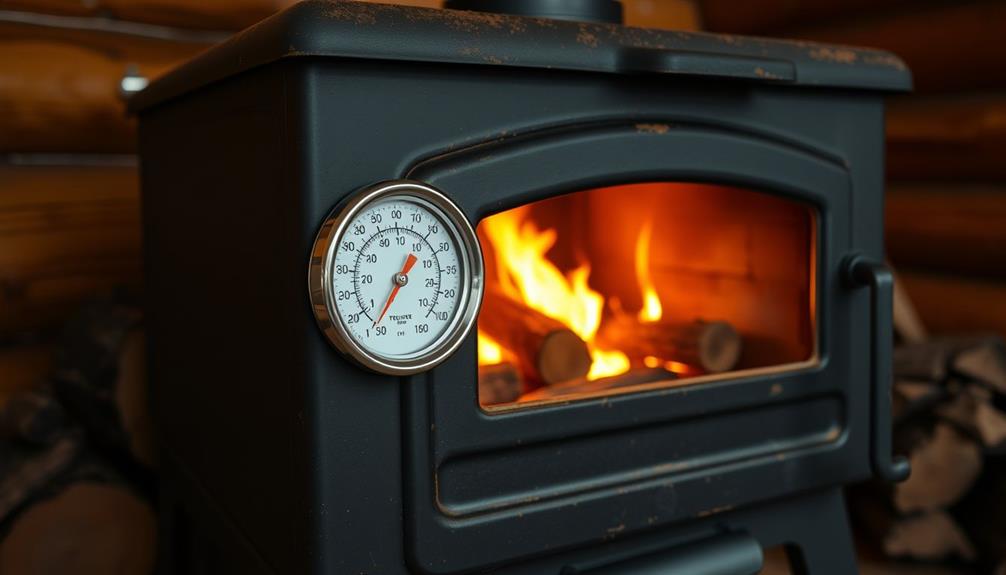
To achieve ideal accuracy with your wood stove thermometer, placement is key. For stove top thermometers, position them near the back of the stove. This spot provides the most reliable readings of surface temperature while keeping them away from direct contact with flames.
If you're using a thermometer on the flue pipe, install it 10-18 inches above the stove. This height effectively monitors exhaust temperatures, guaranteeing both optimal precision and safety. Proper positioning is vital, similar to how the right garage door openers can enhance home security.
When using magnetic thermometers, be cautious—these may not deliver reliable readings when attached to double-wall pipes. Always verify their suitability based on your stove's design.
If you opt for probe thermometers, make sure to drill carefully to avoid smoke leaks, which can compromise accurate internal temperature readings.
To enhance overall precision, consider using multiple thermometers. Placing them in different locations on the stove and flue pipe allows you to compare readings, helping you maximize performance and efficiency.
Understanding Temperature Readings

Understanding temperature readings from your wood stove thermometer is vital for safe and efficient operation. Accurate readings help improve fuel efficiency and prevent excessive smoke, which can lead to dangerous creosote buildup in your chimney.
For reliable flue gas temperature readings, position your stove pipe thermometer 10-18 inches above the stove. Aim for a target temperature of around 300°F during long burns. Additionally, maintaining cleanliness in your wood stove area is important to guarantee ideal airflow and performance, much like how budget-friendly vacuum cleaners help keep your living space tidy.
Keep in mind that surface temperatures on wood stoves can soar between 600°F and 700°F. This necessitates careful monitoring to avoid overheating and potential damage to your stove components. Regularly checking flue gas temperatures is essential; ideally, these should stay below 750°F to prevent chimney fires and maintain safe operation.
Digital thermometers are particularly beneficial since they provide quick and precise readings, responding in under three seconds. This feature allows you to make real-time adjustments to your wood stove operation, helping maintain ideal performance.
Common User Experiences

Accurate temperature readings from your wood stove thermometer can greatly impact your experience, enhancing both efficiency and safety. Many users have shared how proper thermometer usage helps prevent overheating and creosote buildup. You'll find that probe thermometers deliver precise internal readings, but they might degrade over time and need replacing every few years.
On the other hand, magnetic thermometers offer convenience but can lose reliability, leading some to prefer digital options for quick, accurate readings. You'll also want to pay attention to thermometer placement—positioning it near the back of the stove or 10-18 inches above can notably improve accuracy.
Here's a quick overview of user experiences with different types of thermometers:
| Thermometer Type | User Experience |
|---|---|
| Probe | Accurate but may require replacement |
| Magnetic | Convenient but may lose reliability |
| Digital | Quick and precise readings |
Ultimately, as you become more familiar with your wood stove's behavior, you might find you rely less on thermometers, allowing for a more intuitive heating experience.
Maintenance and Care Guidelines

Keeping your wood stove thermometer in prime condition is crucial for safe and efficient heating. To achieve this, regular maintenance is key. Start by cleaning your flue thermometer at the end of each burn season. This helps remove soot and debris that can affect accuracy.
If you're using a probe thermometer, remember to replace it every few years, especially if it's in a high-heat environment. Materials like copper or brass can corrode and lead to inaccuracies. Additionally, monitoring the BTU rating of your stove can help you understand its heating efficiency and guarantee peak performance.
It's also essential to perform calibration checks on your thermometers. Magnetic and analog models can drift over time, leading to unreliable readings. Keep an eye out for signs of wear or damage, as these can also compromise accuracy.
Inaccurate readings can result in unsafe temperature levels and inefficient stove operation.
Lastly, maintaining a seasonal wood moisture content of around 17% not only enhances burning efficiency but also reduces the need for excessive cleaning and maintenance of your thermometers and stovepipes.
Troubleshooting Temperature Discrepancies
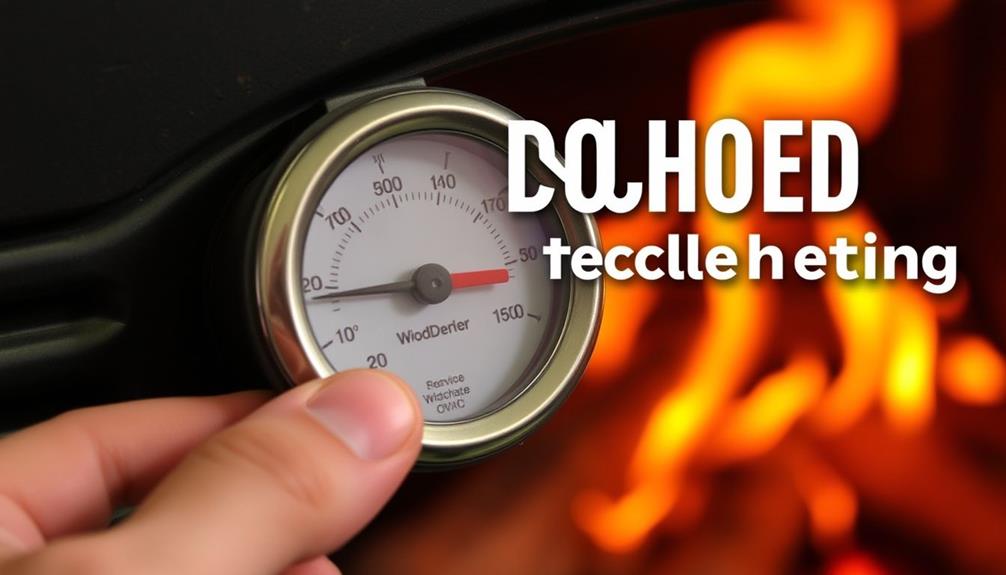
Temperature discrepancies can be frustrating, especially when you rely on your wood stove thermometer for efficient heating. To troubleshoot these issues, start by checking the placement of your thermometers. Stove top thermometers should be situated near the back, while flue thermometers need to be installed 10-18 inches above the stove for ideal accuracy.
Next, consider regular calibration checks. Probe thermometers can degrade over time, necessitating replacement every few years, whereas magnetic ones may be inconsistent but often last longer. It's also wise to compare readings from different types of thermometers, as relying on just one can lead to incomplete data.
Here's a quick reference table to help you identify potential issues:
| Issue | Solution |
|---|---|
| Improper placement | Adjust thermometer location |
| Inconsistent readings | Calibrate or replace thermometer |
| Lack of varied data | Use multiple types of thermometers |
Community Insights and Support
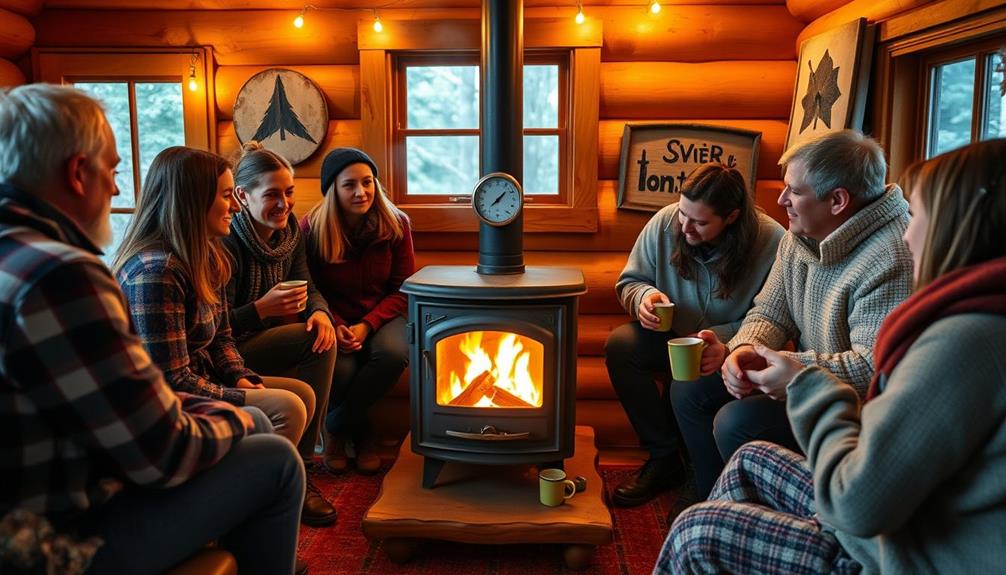
When you engage with communities like ArboristSite, you tap into a wealth of user experiences about wood stove thermometers.
Sharing insights on accuracy and placement can really enhance your understanding and efficiency, especially as you learn about the impact of environmental factors on performance.
Plus, discussing common issues with others helps you troubleshoot and optimize your stove's performance for safer heating.
User Experiences Shared
Many wood stove users have found that sharing their experiences can lead to significant improvements in both safety and efficiency. Accurate temperature readings from thermometers are essential for optimizing your wood stove performance. Some users have reported discrepancies of up to 50°F based on the thermometer's placement or type, highlighting the need for careful selection. Proper monitoring of temperatures can also help in assessing financial goals, similar to how users evaluate their wood stove's performance.
In community discussions, many prefer probe thermometers for their precision, as magnetic options can lose reliability over time. You'll often hear tips about thermometer placement, with advice to position them 10-18 inches above the stove for the best accuracy. This positioning allows for effective monitoring of temperatures, guaranteeing you maintain safe and efficient heating.
Moreover, feedback from users suggests that having multiple thermometers is beneficial. By cross-referencing temperatures, you can manage your wood stove more effectively, leading to improved performance.
Many long-time users emphasize how shared knowledge about thermometer usage has enhanced their experiences, contributing to safer heating practices. By embracing these insights, you can make informed decisions that elevate your wood stove experience and guarantee a cozy, efficient home.
Community Knowledge Exchange
A thriving community of wood stove users offers invaluable insights and support that can greatly enhance your heating experience. Platforms like ArboristSite create spaces for you to exchange knowledge about wood stove operation and thermometer usage.
Within these discussions, you'll discover the critical importance of proper thermometer placement; incorrect positioning can lead to misleading temperature readings that affect your wood stove's efficiency.
You'll often find users comparing different thermometer types, evaluating their accuracy and reliability. This helps you gain a well-rounded understanding of the options available, ensuring you choose the best fit for your needs.
Engaging with fellow wood stove enthusiasts not only provides troubleshooting tips but also fosters a sense of camaraderie that enhances safety in wood heating practices.
The community emphasizes continuous learning, sharing best practices for maintenance and monitoring. By actively participating, you can optimize your wood stove's performance, ensuring it operates safely and efficiently.
Ultimately, connecting with others in this community empowers you to make informed decisions, enhancing both your heating experience and your confidence in using wood stoves.
Frequently Asked Questions
Why Use a Wood Stove Thermometer?
You should use a wood stove thermometer because it helps you monitor temperatures accurately. This guarantees efficient burning, prevents creosote buildup, and reduces the risk of overheating, making your wood stove safer and more effective.
Where Should I Place My Wood Stove Thermometer?
You should place your wood stove thermometer near the back of the stove for accurate readings. For pipe thermometers, install them 10-18 inches above the stove on the flue pipe for ideal temperature monitoring.
What Temperature Should a Wood Stove Flue Be?
Imagine a cozy cabin, warmth enveloping you. Your wood stove flue should ideally hover around 300°F for efficiency, while keeping below 750°F to avoid chimney fires. Monitor those temps to guarantee safe, effective burning.
Do I Need a Flue Thermometer?
You definitely need a flue thermometer. It helps you monitor temperatures accurately, preventing issues like creosote buildup and unsafe burning conditions. Keeping an eye on it guarantees your wood stove operates efficiently and safely.
Conclusion
Just like a ship's compass guides a sailor through stormy seas, wood stove thermometers steer you toward cozy warmth and safety in your home. When you pay attention to their readings, you're not just monitoring temperature; you're nurturing the heart of your space. Embrace the wisdom they offer, and you'll not only enjoy a more efficient burn but also create lasting memories around the fire, where laughter and love gather like embers in the night.

